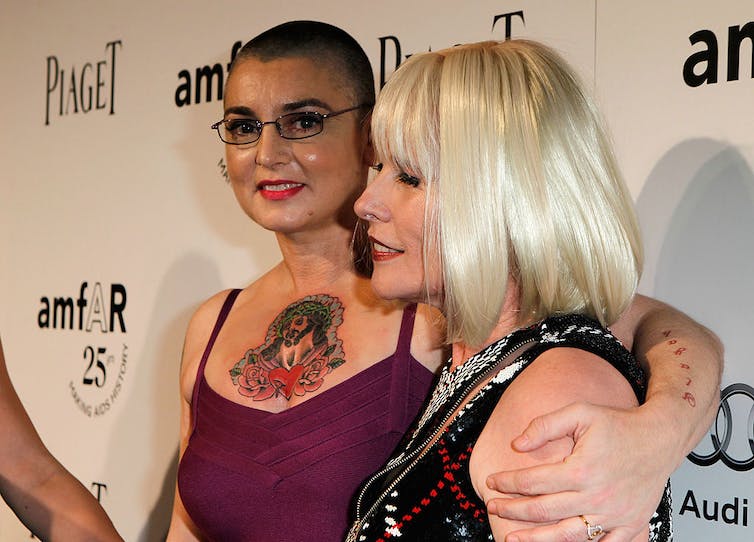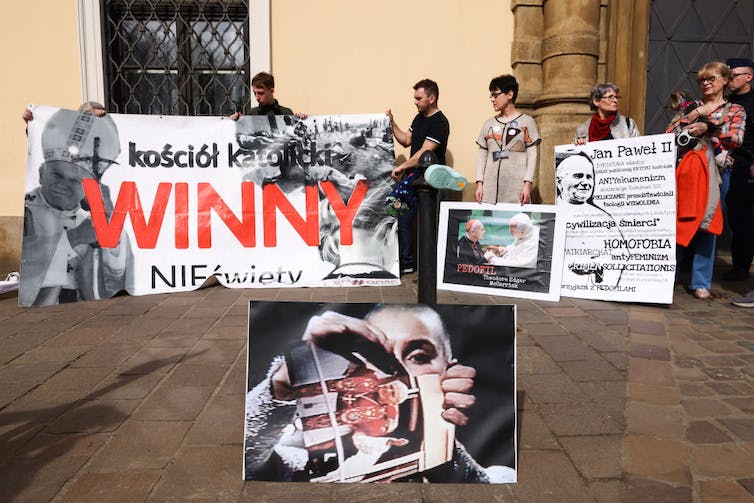Irish singer Sinead O'Connor performs at Paradiso in Amsterdam in March 1988. Paul Bergen/Redferns by way of Getty Images
When information broke July 26, 2023, that the gifted Irish singer Sinead O’Connor had died, tales of her most well-known efficiency circulated amid the grief and shock.
Thirty-one years in the past, after a haunting rendition of Bob Marley’s track “War,” O’Connor ripped up {a photograph} of Pope John Paul II on reside tv. “Fight the true enemy,” she stated – a reference to clerical intercourse abuse. For months afterward, she was banned, booed and mocked, dismissed as a loopy insurgent past the pale.
Commemorations following her loss of life, nevertheless, solid the protest in a really totally different gentle. Her “Saturday Night Live” efficiency is now seen as “invigorating,” the New York Times’ pop critic wrote, and “a name to arms for the dispossessed.”
Attitudes towards Catholicism, intercourse and energy are far totally different in the present day than in 1992, whether or not in New York or O’Connor’s native Dublin. In many individuals’s eyes, the ethical credibility of the Catholic Church world wide has crumbled, and belief in religion establishments of any type is at an all-time low. Sexual abuse, as soon as mentioned solely in whispers, is now starting to be talked about overtly.
I be part of the refrain of voices in the present day who say O’Connor was many years forward of her time. But leaving it simply at that, we miss one thing profound in regards to the complexity and depth of her spiritual creativeness. Sinead O’Connor was arguably one of the vital spiritually delicate artists of our time.
I’m a scholar of Catholicism within the trendy period and have lengthy been inquisitive about these figures – the poets, artists, seekers – who wander the margins of their spiritual custom. These women and men are dissatisfied with the mainstream facilities of spiritual energy however nonetheless compelled by one thing indelibly spiritual that feeds the wellsprings of their creative creativeness.
Throughout her life, O’Connor defied spiritual labels, exploring a number of faiths. The beautiful freedom in her music can’t be disentangled from that one thing transcendent that she was at all times after.
‘Rescuing God from faith’
Religion is usually thought of as discreet traditions: establishments that somebody is both inside or outdoors. But on the bottom, it’s not often that straightforward.
The Catholic Church had a powerful maintain on Irish society as O’Connor was rising up – a “theocracy,” she known as it in interviews and her memoir, “Rememberings” – and for a few years she known as for extra accountability for the clerical abuse disaster. But she was additionally open in her love of different points of the religion, albeit usually in unorthodox methods. She had a tattoo of Jesus on her chest and continued to critique the church whereas showing on tv with a priest’s collar.

Sinead O’Connor, along with her tattoo of Jesus, embraces singer Deborah Harry on the 2011 amfAR Inspiration Gala in Los Angeles.
Jeff Vespa/Getty Images for amfAR
Ten years after her SNL efficiency, O’Connor took programs at a seminary in Dublin with a Catholic Dominican priest, Rev. Wilfred Harrington. Together, they learn the prophets of the Hebrew Bible and the Psalms: sacred scriptures during which God’s voice comes by in darker, moodier, extra human types.
Inspired by her trainer, she made the beautiful album “Theology,” devoted to him. The album is a mixture of a few of her personal songs impressed by the Hebrew Bible – like “If You Had a Vineyard,” impressed by the Book of Isaiah; and “Watcher of Men,” which pulls from the biblical story of Job – and different tracks that basically are sung variations of her favourite Psalms.
In a 2007 interview with Fordham University’s WFUV radio station, O’Connor stated that she hoped the album may present God to folks when faith itself had blocked their entry to God. It was a sort of “rescuing God from faith,” to “elevate God out of faith.” Rather than preaching or writing, “music is the little manner that I do this,” she stated, including, “I say that as somebody who has a whole lot of love for faith.”
Reading the prophets
In doing so, she stood within the lengthy line of the prophetic custom itself.
The nice Jewish thinker Rabbi Abraham Joshua Heschel’s ebook “The Prophets” begins with this sentence: “This ebook is about a number of the most annoying individuals who have ever lived.” Over and over, the Bible reveals the prophets – the prophets who impressed “Theology” – mounting bracing assaults on hypocrisies and insincerities in their very own spiritual communities, and never politely or calmly.

A photograph of Sinead O’Connor ripping the {photograph} of Pope John Paul II stands in entrance of a protest in Krakow, Poland, in 2023, accusing church hierarchy of masking up sexual abuse.
Beata Zawrzel/NurPhoto by way of Getty Images
To many horrified Catholics, O’Connor’s SNL look and her many different criticisms of the church had been blasphemous – or, at finest, simply throwing stones from outdoors the church for consideration. Other followers, nevertheless, noticed it as prophetic condemnation. It was not only a critique of kid abuse however of church officers’ professed compassion for youngsters – sanctimonious pieties as they lined up the abuse.
In calling this out and a lot extra, O’Connor was usually seen as disturbing: not simply the photo-of-the-pope incident, however her androgyny, her shaved head, her openness round her personal struggles with psychological sickness. But for a lot of admirers, because the documentary “Nothing Compares” makes clear, all this confirmed that she was free, and just like the prophets of previous, unashamed and unafraid to impress.
Rasta to Islam
At the identical time, O’Connor’s spiritual creativeness was a lot greater than a posh relationship with Catholicism. Religion round O’Connor was eclectic and intense.
She was deeply influenced by Rastafarian traditions of Jamaica, which she described as “an anti-religious however massively pro-God religious motion.” She thought of Sam Cooke’s early album with the Soul Stirrers the most effective gospel album ever made. She counted amongst her religious heroes Muhammad Ali – and transformed to Islam in 2018, altering her identify to Shuhada’ Sadaqat.

O’Connor performs throughout a live performance on the Admiralspalast in Berlin in December 2019, after her conversion to Islam.
Frank Hoensch/Redferns by way of Getty Images
Yet O’Connor’s imaginative and prescient was not fragmented, as if she had been always chasing after bits and items. The miracle of Sinead O’Connor is that all of it coheres, by some means, within the phrases of an artist who refuses to lie, to cover or not say what she thinks.
When requested about spirituality, O’Connor as soon as stated that she most well-liked to sing about it, not discuss it – as she does in so many songs, from her luminous singing of the antiphon, a Marian hymn sung at Easter providers, to her Rasta-inspired album, “Throw Down Your Arms.”
In “Something Beautiful,” a monitor from the “Theology” album, O’Connor speaks each to God and the listener: “I wanna make/ Something stunning/ For you and from you/ To present you/ I am keen on you.”
Indeed she did. To be moved by her artwork is to sense a transcendence, a peek into radiance.
![]()
Brenna Moore doesn’t work for, seek the advice of, personal shares in or obtain funding from any firm or group that might profit from this text, and has disclosed no related affiliations past their educational appointment.
